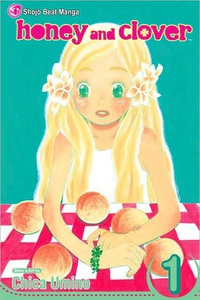Review
by Casey Brienza,Honey and Clover
GN 1-2
| Synopsis: |  |
||
Yuta Takemoto has moved to Tokyo to attend art school. Along with fellow classmates Shinobu Morita and Takumi Mayama who in the same decrepit apartment building, he struggles with schoolwork, poor eating habits (too little protein in their diets), and unrequited love. Both he and Morita, a misanthropic money-hound who seems incapable of graduating, fall in love with the sprite-like niece of their professor, Hagumi “Hagu” Hanamoto. Meanwhile, Mayama has fallen for their professor's friend, the quietly tormented Rika Hamada, and another classmate named Ayumi “Ayu” Yamada has fallen hard for Mayama. The story follows Takemoto's maturation, Morita's failure to graduate, and the evolution of everyone's professional and personal lives. |
|||
| Review: | |||
In some cases, winning prizes is a proud sign of merit. In other cases, it is an ignominious sign of how far a once mighty field of contenders has declined over the years. And despite many valiant attempts to recast Chica Umino's Honey and Clover, which won the 2003 Kodansha Manga Award and was nominated for several others, as heir to the shoujo manga greats of a generation ago, it is hard to see the accolades it has received as anything other than overwrought presumption…and the manga itself as anything other than overhyped pabulum. Not that Umino appeared to be aspiring to all that much with this series in the first place. Much of her effort feels modest or just misplaced. This is a classic in the making only to those who were not expecting much of anything in the first place. Expect nothing and you'll never be disappointed, right? The artwork is standard in its josei manga look, quite similar to that of Moyoco Anno's Happy Mania or Chihiro Tamaki's Walkin' Butterfly, with plenty of sketchy line work and little screentoning. Many scenes are quite busy, and panel sequences are poorly paced and not especially cinematic. The story itself is as jerky as the art. Most of the chapters are standalone episodes that somehow involve eating (excessively), drinking (even more excessively), or vacationing (what about school?). In the first volume, the characters gorge themselves on croquettes and sausages, get drunk on Christmas, and head to the beach. In the second volume, the characters gorge themselves on their parents' largesse, get drunk at a hot springs resort, and head to the zoo. A pattern seems to be emerging here… Most of the rest of the plot involves the characters' two love triangles; progress in that respect seems to happen at a snail's pace. But really, the plot and the art are not reasons why anyone would want to read Honey and Clover. The primary draw is, without question, the characters and their (theoretically) hilarious antics. Indeed, except for Takemoto, the only normal boy of the bunch, they are seriously weird. Money-grubbing Morita, who seems unable to graduate or express affection in a normal way, in particular. But “Iron Man” Ayu is an odd bird too, and one wonders if she will ever be able to win over the sometimes pathetic Mayama. They and their lives are supposed to be funny, and much of the manga is played for laughs. Unfortunately, the oddball, misanthropic humor is an acquired taste, and not everyone will find it even remotely funny. If you laugh, the chances are as good as not that it is because these annoying personages are being tortured by an impromptu game of Twister or something similar. Honey and Clover has a wide sadistic streak. The pint-sized Hagu, on the other hand, is outright creepy—among the most disturbing characters to appear in a shoujo manga in recent memory, in fact. She looks like a wan, pale child, and she hardly ever speaks in articulate sentences. The first two things she ever says are “Here” (serving tea in chapter one) and “Nooooo I hate you, go away” (fleeing Morita's attentions in chapter two). She is the least threatening love object imaginable, and naturally two of the men are romantically obsessed with her. Hagu is, in short, every gross stereotype of the ideal Japanese woman—silent, subservient, and small—come to life, the logical conclusion of Japan's incomplete modernization that the moé and lolicon genres make repulsively manifest. One expects this sort of misogyny from a male mangaka. But it is especially deplorable when it issues from the pen of a woman. In any case, it really is a shame that Umino's manga does not live up to the reputation that precedes it. The Viz Media edition has been translated and adapted by Akemi Wegmüller, whose work on such complex and culturally specific works as Usamaru Furuya's Short Cuts and Novala Takemoto's Kamikaze Girls novel deserves to win awards in its own right. Yet even she cannot save it from a torpid, Zen Buddhist-like obsession with the ordinary that, ultimately, makes Honey and Clover itself little more than ordinary. |
| Grade: | |||
|
Overall : C-
Story : D+
Art : B-
+ A large cast of weird characters subject to a large number of silly, weird situations |
|||
| discuss this in the forum (94 posts) | | |||
| Production Info: | ||
|
Full encyclopedia details about Release information about |
||